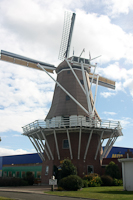
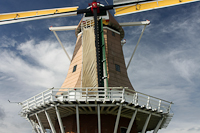
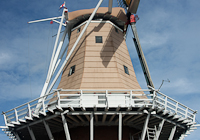
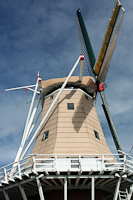
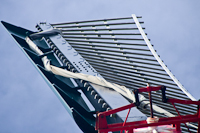
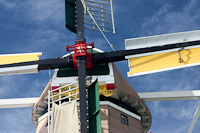
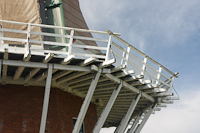
One of the fun things about driving around New Zealand is that not only do you get the beautiful countryside but every so often something unexpected pops into view. The low flying restaurant built out of the body of a DC3, the Giant Carrot in Ohakune, the replica Stonehenge over in the Wairarapa and the like. But who would have thought that a country that was heavily settled in mostly the early nineteenth could feature a 17th century design of Dutch windmill?
Yet this is precisely what Foxton has on its main street. Built in 2003 it is a fully working mill producing stone ground floor for people to buy. Even better you can get tours of mill for a fairly modest fee and learn a lot about how they work. While it is on the main road of Foxton that isn't the main thoroughfare through the region so you do have to turn off the state highway and detour a little bit to get to it. But once there you can find a transport museum (mostly dedicated to buses), cinema museum (for early cinema equipment), a flax stripping museum (complete with functional thresher and stripper machines from the period when flax harvesting boomed) and a radio museum all located within easy walking distance of the windmill. Consequently it serves as a convenient hub and doubles as the visitor information centre for people coming in to the town.
There is one minor quibble I have - 'deMollen' simply means 'the Windmill' in Dutch. So we have a building which is literally 'The Windmill Windmill' in a lot of the literature referencing it. But as you can see from the photographs below it has an imposing presence - over four stories tall internally and much higher once you count the blade span in it is very hard to miss. It doesn't hurt that Foxton is mostly single to double story buildings and so this towers over the rest of the town. You can see in the background of the first photograph a fairly large Mitre10 warehouse style store and the windmill easily extends above it. The nice side effect of this is that the view from the exterior deck is excellent offering a good panorama - including at the time snow visible on the mountains in the distance, something I sadly didn't get a good photograph of.
But the exterior is only the begining. Once inside and above the bottom floor the windmill becomes this warm wooden space with a strong timber smell to it. Giant cogs, the millstone itself and the whole mechanical linkages are exposed making it a fascinating space to explore. It doesn't hurt that on the day I visited with my cousin we had a knowledgable guide who was one of the primary driving forces behind the mill being built. He happily chatted about how the mill worked, the tricks of the wind that affect when grinding can occur, where he sourced some of the components and even was kind enough to let me get right into the highest space of the mill. Normally one can't access that topmost floor because when the windmill is active then the potential to be caught and hurt by the transfer linkage is very real. But at the time we visited the blades were parked and locked down awaiting the evening sea-breeze later in the day.
All in all it is worth seeing just to get a good glimpse into the state of the art circa the 17th Century. While it is large and chunky it still is a very refined and clever design - like the use of a centripetal advance to regulate the speed the blades turn giving automated braking or speed control. It is a good reminder that while our ancestors might not have had the same materials available to them they still were clever and often had very subtle touches to their designs that can easily be overlooked or forgotten today. It didn't help that it was fairly bright outside and the interior is a little dark which has meant I have had to spend a bit of time trying to combat the harsh exposure blowouts that light direct from windows was causing. There simply wasn't enough room to keep every window out of shot and still capture the piece of aparatus properly - the mill might be big but a lot of the space is definitely used. This made for fairly moody lighting as the shot of the sunlight through the stair ballistrades demonstrates.
It doesn't hurt that on the way back to Wellington you have to drive past Kapiti Island. I have talked about visiting the island itself elsewhere on this website but I didn't cover the spectacular views it dominates. The whole Raumati beach/Paraparaumu region has Kapiti out to the West providing relief in spectacular sunsets. During summer the sun sets very close to the top of the South Island with the associated headlands and islands framing it. For those visiting Wellington it is about a ninety minute drive up the country to reach Foxton so could be worth doing what my cousin and I did - make a day trip out of it and go see one of the more unusual buildings to be seen in New Zealand.